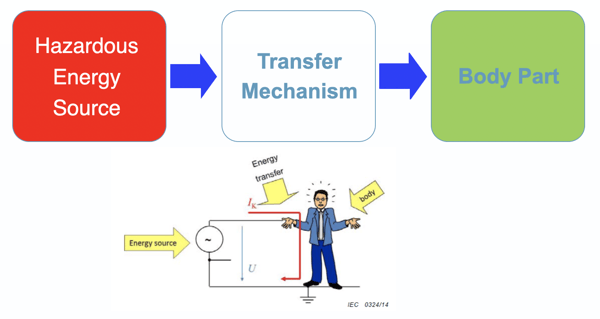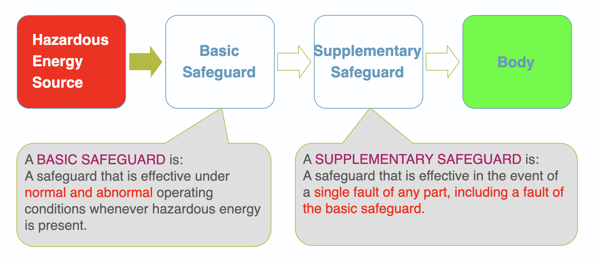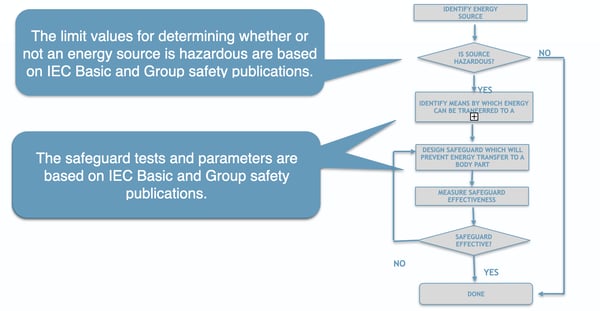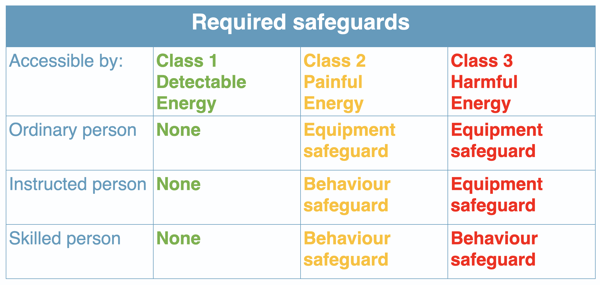- Services
- Industries
- Automotive
- Battery
- Building inspection
- Fire alarms system testing
- Household appliances
- Installation materials
- Industrial machinery
- IT & audio video
- Laboratory, test & measurement
- Lighting equipment
- Maritime, oil & gas
- Medical & healthcare equipment
- Military & aerospace product testing
- Wireless & telecom
- Resources
- About
- Blog
- Events
The implementation date of the hazard-based standard is fast approaching. Here’s how to prepare.
IEC 62368–1, also known as the hazard-based standard, is a new safety standard that covers products currently under the scopes of IEC 60065 and 60950-1. Replacing both the existing standards for ICT/AV equipment, the hazard-based standard represents a new approach that is fundamentally different from its predecessors.
Tip: If you’re new to the product development process, we recommend that you also read our general guide for product developers – 6 Steps From Idea To Market – and learn how to avoid non-conformities and costly time-delays.
The hazard-based standard is meant to safeguard users against energy sources within products, including components and subassemblies. In contrast, the previous standards were incident-based, which means they were formulated in response to undesirable incidents. The hazard-based standard takes a more proactive stance towards hazards.
Does The Hazard-based Standard Affect Me?
If your current or future portfolio contains ICT/AV products, then yes.
Whether your product has been certified to the earlier standards, or you’re looking to get a first-time certification, you are required to get it approved in accordance with the hazard-based standard.
Want to get a quick overview? Read our 2-minute Guide to The New ICT/AV Standard
The Six Hazards Covered by the Standard
The hazard-based standard covers all kinds of hazardous energy sources. The general scenario it addresses is as follows:

Let’s take a brief look at the different hazardous energy sources typically present in ICT/AV equipment.
Electric shock
Electric power is of course the common denominator for almost every ICT/AV product and is the usual suspect when serious user injuries occur. The hazards range from harmless static electricity to fatal electric shocks due to users coming in direct contact with the mains electricity supply.
Fire
ICT/AV equipment can catch fire either by electrical faults like a short circuit, or – when batteries are involved – by internal chemical reactions, for example when a lithium-ion battery gets structurally damaged.
Chemicals
Hazardous chemicals can cause injury to body parts. In the context of ICT/AV equipment, such substances are typically present in batteries. Ozone producing equipment like copying machines are also within the scope here.
Mechanical
Mechanical hazards include sharp edges, moving parts (including cooling fans), exploding or imploding parts, instability (a product can tip over), and improperly mounted equipment (potentially falling down from the wall or the ceiling).
Burn
Electric appliances generate heat, and certain parts can heat up to the point where they can cause thermal injuries (skin burn) on contact.
Radiation
The standard addresses various kinds of radiation, like LEDs, lasers and X-rays. It also covers sound, but the scope is limited to personal music players only. There are strict limitations on permitted levels for each of the categories.
How to Design an Effective Safeguard
There are a couple of different ways to safeguard the user, depending on the energy class of the source. This principal scheme illustrates how the safeguards are placed between the energy source and the user (body). Notice how the user must be protected in both normal and abnormal use of the product, and in the event of a single fault of any part.

There are four different types of safeguards:
- Equipment safeguard (e.g. the enclosure around your television)
- Installation safeguard (e.g. the wall socket-outlet)
- Personal safeguard (e.g. protective equipment such as a helmet or gloves)
- Behavioural safeguard (e.g. “Only to be operated by trained personnel”)
In the context of the hazard-based standard, the safeguard requirements are determined by:
- the persons that have access to the product, and
- the energy source classification
Determining what safeguards are appropriate for your product is an important part of the approval process. Experienced product developers probably have a good sense of what to look out for, but newcomers will likely benefit from seeking out guidance from a professional.
Read more: Guide for Product Developers: 6 Steps From Idea to Market
The Safety Evaluation Process
The safety evaluation process itself is straightforward. That being said, certain hazards may not be obvious to the untrained eye, and reliable testing requires specialized equipment and know-how.
Some product developers – typically at larger, well-established companies – can draw on substantial internal resources and do most of the safety evaluation in-house. Others, such as startups, will require professional assistance from start to finish. In either case, the safety evaluation process is as follows:
- Identify any energy sources in your product.
- Determine whether they are hazardous. If they’re not, you can skip to #7.
- If they are, check whether that energy has a means of being transferred to a body part through normal or abnormal use.
- If it has, you have to design a safeguard which will prevent energy transfer to the body part.
- Measure the effectiveness of the safeguard.
- Was it effective?
Yes? Great! Go ahead and jump to # 7.
No? Improve the design of the safeguard and repeat the process from #5. - Great job, you can move on.

How to Prepare for Product Certification/Approval
If your product performs satisfactorily in the safety evaluation process, the next step is to attain a formal approval by a TIC (Testing, Inspections and Certifications) body.
There’s still some work to do on your part, however. These next paragraphs outline what you should prepare before you hand over your product to the TIC body.
-
Product Description, Documentation and Manuals
Product description, including possible manuals, must be available up front to give information about intended use, et cetera. Furthermore, all critical components within a product must be adequately documented. This could be in the form of certificates, reports and/or data sheets.
-
Persons Overview – Who Will Have Access to Your Product?
Make sure to have an overview of what kind of persons that may have access to your product. The standard covers Ordinary, Instructed and Skilled persons.
-
Energy Classifications
The six energy sources/hazards must be classified (1, 2 or 3) in order to determine the required safeguards. Classification can be done by a combination of declarations, calculations and measurements. Possible declared energy sources must be informed about upfront. The TIC body will verify the different energy source classifications by calculation and measurements.
As soon as these things are in place, the TIC body will perform relevant testing to verify that the required safeguards are in place. Upon completion of testing, required reports and certificates will be issued.
Key Takeaways
- The hazard-based standard replaces IEC 60065 and 60950-1
- It affects all existing and planned ICT/AV products
- The standard covers six hazardous energy sources:
- Electrical
- Fire
- Chemicals
- Mechanical
- Burn
- Radiation
- As a product developer, you’re required to protect the user from the hazards, using safeguards via a standardized approach.
- Your safeguards’ effectiveness is determined by a safety evaluation process.
- Before you embark on the certification process, you should prepare various types of documentation like manuals, product description, persons overview and energy classifications.
Tags:
Hazard based
Ole Morten Aaslund
Ole Morten Aaslund is responsible for projects with the safety laboratory in Norway. He has extensive experience within the ICT/AV-areas, and has been with Nemko, in the Norway office, since 1996. He has been organising and hosting Hazard-Based workshops and developing GAP analysis for some of the world's largest...


